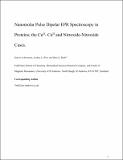Files in this item
Nanomolar pulse dipolar EPR spectroscopy in proteins : CuII-CuII and nitroxide-nitroxide cases
Item metadata
| dc.contributor.author | Ackermann, Katrin | |
| dc.contributor.author | Wort, Joshua | |
| dc.contributor.author | Bode, Bela Ernest | |
| dc.date.accessioned | 2021-05-18T09:30:36Z | |
| dc.date.available | 2021-05-18T09:30:36Z | |
| dc.date.issued | 2021 | |
| dc.identifier | 274027217 | |
| dc.identifier | 6b7bb216-6ccc-44ff-8e2d-367742e5b4ae | |
| dc.identifier | 85107084689 | |
| dc.identifier | 000657362700017 | |
| dc.identifier.citation | Ackermann , K , Wort , J & Bode , B E 2021 , ' Nanomolar pulse dipolar EPR spectroscopy in proteins : Cu II -Cu II and nitroxide-nitroxide cases ' , Journal of Physical Chemistry B , vol. Articles ASAP . https://doi.org/10.1021/acs.jpcb.1c03666 | en |
| dc.identifier.issn | 1520-6106 | |
| dc.identifier.other | ORCID: /0000-0002-3384-271X/work/93161480 | |
| dc.identifier.uri | https://hdl.handle.net/10023/23215 | |
| dc.description | This research was funded, in whole or in part, by the Wellcome Trust (099149/Z/12/Z and 204821/Z/16/Z). A CC BY or equivalent license is applied to the author-accepted manuscript arising from this submission, in accordance with the grant’s open-access conditions. B.E.B. and K.A. acknowledge support by the Leverhulme Trust (RPG-2018-397). J.L.W. was supported by the BBSRC DTP Eastbio. B.E.B. acknowledges equipment funding by BBSRC (BB/R013780/1). | en |
| dc.description.abstract | The study of ever more complex biomolecular assemblies implicated in human health and disease is facilitated by a suite of complementary biophysical methods. Pulse Dipolar electron paramagnetic resonance Spectroscopy (PDS) is a powerful tool that provides highly precise geometric constraints in frozen solution, however the drive towards PDS at physiologically relevant sub-μM concentrations is limited by the currently achievable concentration sensitivity. Recently, PDS using a combination of nitroxide and CuII based spin labels allowed measuring 500 nM concentration of a model protein. Using commercial instrumentation and spin labels we demonstrate CuII-CuII and nitroxide-nitroxide PDS measurements at protein concentrations below previous examples reaching 500 and 100 nM, respectively. These results demonstrate the general feasibility of sub-μM PDS measurements at short to intermediate distances (~1.5 - 3.5 nm), and are of particular relevance for applications where the achievable concentration is limiting. | |
| dc.format.extent | 601799 | |
| dc.language.iso | eng | |
| dc.relation.ispartof | Journal of Physical Chemistry B | en |
| dc.subject | EPR spectroscopy | en |
| dc.subject | Structural biology | en |
| dc.subject | PELDOR/DEER | en |
| dc.subject | RIDME | en |
| dc.subject | Double-histidine motif | en |
| dc.subject | QD Chemistry | en |
| dc.subject | DAS | en |
| dc.subject | SDG 3 - Good Health and Well-being | en |
| dc.subject.lcc | QD | en |
| dc.title | Nanomolar pulse dipolar EPR spectroscopy in proteins : CuII-CuII and nitroxide-nitroxide cases | en |
| dc.type | Journal article | en |
| dc.contributor.sponsor | The Wellcome Trust | en |
| dc.contributor.sponsor | The Wellcome Trust | en |
| dc.contributor.sponsor | The Leverhulme Trust | en |
| dc.contributor.sponsor | BBSRC | en |
| dc.contributor.institution | University of St Andrews. School of Chemistry | en |
| dc.contributor.institution | University of St Andrews. Biomedical Sciences Research Complex | en |
| dc.contributor.institution | University of St Andrews. Centre of Magnetic Resonance | en |
| dc.contributor.institution | University of St Andrews. EaSTCHEM | en |
| dc.identifier.doi | 10.1021/acs.jpcb.1c03666 | |
| dc.description.status | Peer reviewed | en |
| dc.date.embargoedUntil | 2021-05-17 | |
| dc.identifier.grantnumber | 099149/Z/12/Z | en |
| dc.identifier.grantnumber | 204821/Z/16/Z | en |
| dc.identifier.grantnumber | RPG-2018-397 | en |
| dc.identifier.grantnumber | BB/R013780/1 | en |
This item appears in the following Collection(s)
Items in the St Andrews Research Repository are protected by copyright, with all rights reserved, unless otherwise indicated.

